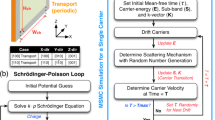Abstract
In this work, we present a quantum mechanical approach for the simulation of Si/SiO2 interface roughness scattering in silicon nanowire transistors (SNWTs). The simulation domain is discretized with a three-dimensional (3D) finite element mesh, and the microscopic structure of the Si/SiO2 interface roughness is directly implemented. The 3D Schrödinger equation with open boundary conditions is solved by the non-equilibrium Green’s function method together with the coupled mode space approach. The 3D electrostatics in the device is rigorously treated by solving a 3D Poisson equation with the finite element method. Although we mainly focus on computational techniques in this paper, the physics of SRS in SNWTs and its impact on the device characteristics are also briefly discussed.
Similar content being viewed by others
References
Y. Cui et al., “High performance silicon nanowire field effect transistors,” Nano Lett., 3, 149 (2003).
B.S. Doyle et al., “High performance fully-depleted tri-gate CMOS transistors,” IEEE Elect. Dev. Lett., 24, 263 (2003).
M.V. Fischetti et al., “Six-band k·p calculation of the hole mobility in silicon inversion layers: Dependence on surface orientation, strain, and silicon thickness,” J. App. Phys., 94, 1079 (2003).
F. Gamiz et al., “Role of surface-roughness scattering in double gate silicon-on-insulator inversion layers,” J. App. Phys., 89, 1764 (2001).
A. Gold, “Electronic transport-properties of a two-dimensional electro-gas in a silicon quantum-well structure at low-temperature,” Phys. Rev. B, 35, 723 (1987).
K. Uchida et al., “Experimental study on carrier transport mechanism in ultrathin-body SOI n- and p-MOSFETs with SOI thickness less than 5 nm,” Int. Elect. Dev. Meet., 47 (2002).
J. Wang et al., “A three-dimensional quantum simulation of silicon nanowire transistors with the effective-mass approximation,” J. App. Phys., 96, 2192 (2004).
S. Datta, “Nanoscale device modeling: The Green’s function method,” Superlattices Microstruct., 28, 253 (2000).
S.M. Goodnick et al., “Surface roughness at the Si(100)-SiO2 interface,” Phys. Rev. B, 32, 8171 (1985).
S. Horiguchi, “Validity of effective mass theory for energy levels in Si quantum wires,” Physica B, 227(1–4), 336 (1996).
Author information
Authors and Affiliations
Corresponding author
Rights and permissions
About this article
Cite this article
Wang, J., Polizzi, E., Ghosh, A. et al. A Quantum Mechanical Approach for the Simulation of Si/SiO2 Interface Roughness Scattering in Silicon Nanowire Transistors. J Comput Electron 3, 453–457 (2004). https://doi.org/10.1007/s10825-004-7095-0
Issue Date:
DOI: https://doi.org/10.1007/s10825-004-7095-0




